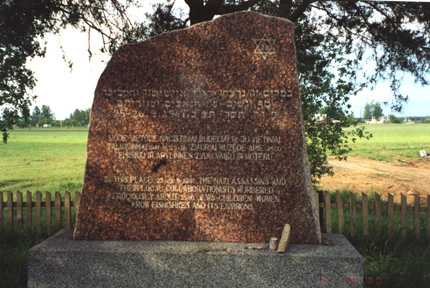Last summer, Rita and I experienced probably the most physical and
emotional 18 day trip we have ever taken in our almost 50 years of
marriage. The
trip was an American Jewish Congress Tour highlighting the lost Jewish
communities
and the Nazi concentration camps and killing fields throughout Poland,
Lithuania,
Hungary, and the Czech Republic.
One of the main reasons we went on the trip was because its itinerary
included Vilna or Vilnius, the capital of Lithuania. About 3
years ago, I discovered that my maternal ancestors came from the shtetl
of Eishyshok, about 30 miles from Vilna. While I knew that
the
shtetl was completely annihilated by the Germans in World War II and
that only a few Jews survived the massacre, I did want to see my
ancestral home. If any of you have been to the Holocaust
Museum
in Washington DC, you may recall the “Tower of
Life” exhibit that
Professor Yaffa Eliach set up in the Museum depicting hundreds of
pictures of Eishyshok families killed by the Germans.
Professor
Eliach has written a wonderful book on Eishyshok called
“There Once was
a Town” a 900 year history of the Jews of
Eishyshok. A 90-minute
TV documentary on the book was shown on PBS on the East Coast
last Rosh Hashana.. The video is narrated by
Ed Asner, whose family came from one of the small
‘suburbs’ of
Eishyshok..
Rita and I and another couple from the AJC tour hired a guide and
driver to take us to Eishyshok from Vilna. At its height,
Eishyshok was a prominent
Jewish shtetl as Jews had been there for 900 years. It had a large and
eminent
Yeshiva and a very active Jewish life. After arriving in the shtetl we
discovered
that the guide had never been there and knew nothing of its history.
Thanks
to Rita’s foreign language proficiency we were able
to talk to
some
of the local people. We discovered that in 1939, Eishyshok and its
environs
had about 5000 people, 4000 Jews and 1000 Poles/Lithuanians and
Russians.
When we asked to see the Jewish cemetery, we found a young man of 17,
Tomas,
who said he knew the place where the Jewish men were buried and another
place,
where the Jewish women were buried. He said they were about a mile or
so
out of town and he would take us there. We said, while
orthodox
Jewish
women and men may pray separately, they were buried in the
same
place,
and although what he said didn’t make sense to us, we went
with him.
We drove out to a large field and
after getting
out
of the car we walked about 200 feet to a small area enclosed by a
wooden
fence. Inside the enclosed area there was a monument written
in 3
languages:
Hebrew, English, and Lithuanian. The words on the
memorial
said:
“On September 25-26 1941, the murderous Nazis and their local
collaborators
viciously killed 2500 Jewish women and children from Eishyshok and its
environs
on this spot.”
Tomas then took us to another area about
a mile or so
away.
A similar memorial was there which used the same words and said on this
spot
on the same two days the Nazis viciously killed 1500 Jewish men from
Eishyshok.
 The monument for the Jewish men
The monument for the Jewish men
So, apart from a handful of survivors who were able to escape into the
woods, or were sheltered by some local Lithuanians, the Germans wiped
out the entire shtetl in two days. While most of my direct
line
relatives left Eishyshok in the late 1880’s and
1890’s, I am sure that
there were some of my more distant
relatives among those 4000 poor souls who were killed during those two
days.
Needless to say, seeing these two memorials was one of the most
emotionally
draining experiences I have ever encountered.
In addition to the two memorials, Tomas introduced us to his
Grandfather, a man of about 75 who showed us where the synagogue,
cemetery and mikva once were in Eishyshok. The building that
housed the synagogue was used by
the Germans as a storage building and then by the Russians as a sports
arena.
It is now abandoned and in ruins. The Germans destroyed the
old
Jewish
cemetery and the Russians built a school over it, which is now also
abandoned.
If one ignores the paved streets, the electrical and telephone lines,
Eishyshok
looks like the village from “Fiddler on the Roof,”
small wooden
buildings
with tin roofs, dirt sidewalks, out houses just like
something
out
of the 19th century. Today Eishyshok has about 3500 people-no
Jews.
 The former mikvah
The former mikvah
As I said, the 18 days spent on the tour was a very emotional and moving
and enduring experience. In particular, the trip to Eishyshok allowed
me to walk the streets where my maternal grandparents, great
grandparents and great-great grandparents were born and lived a good
part of their lives. Throughout the trip, we visited the
places
that were once the homes, work place, synagogues and yeshivas of the
forefathers and foremothers of probably 80-90% of American
Jews.
Most of these places no longer exist-as they were destroyed during the
Holocaust. At the appropriate time in your life I suggest
that
each
and every one of you visit these important places in our
History.
We
must always remember where we came from and hold in reverence the
beautiful heritage that once existed in these places. My
shtetl
of Eishyshok is
only one of many-in each of these places “THERE ONCE WAS A
TOWN.”
 Trip to
Eishyshok - 2000
Trip to
Eishyshok - 2000

